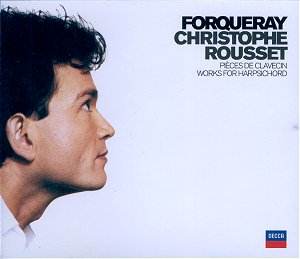Antoine Forqueray was a consummate composer of music
for the viol, his instrument of predilection. In 1747, after his death,
his son Jean-Baptiste published a set of his fatherís music in two scores:
one for the viol, the other "set as pieces for the harpsichord"
(including three movements composed by Forqueray fils, though
it is possible that the son actually composed all of the music, and
merely used his fatherís well-known name for marketing purposes). This
recording presents the harpsichord version of these works, which appear
as a model for harpsichord transcriptions of solo music, but also as
works in their own right.
Since the original viol pieces were written for the
solo bass viol, the transcriptions lean toward the heavier end of the
harpsichord. This gives music that does not sound idiomatic to the instrument,
since most harpsichord uses the left-hand as accompaniment rather than
melodic parts. This is not the case in all of the pieces.
Christophe Rousset is a fine harpsichordist, but on
this recording, he sounds as if he is lacking direction. His tempi often
tend to be very fast, as if he were in a hurry to play this music, and
this to the detriment of the melodic aspects of these pieces. In addition,
I find the instrument used, the Hemsch harpsichord belonging to the
Musée de la musique in Parisís Cité de la musique, particularly
unsuited for these works. Its low range sounds very muddy and busy,
especially with the excessive ornamentation which is common with this
music; in the virtuoso final movement of the fifth suite, Jupiter, the
music is almost hidden by the "noise" of the instrument, and
Rousset seems almost lost in the breakneck speed of the piece, slipping
away from the rhythm.
This harpsichord does sound excellent, however, in
movements such as the Sarabande: La DíAubonne in the fourth suite. This
movement sounds much more like a harpsichord piece, with its melody
in the high range of the instrument, and all of this harpsichordís subtle
sounds are heard in this piece.
Yet, the overall impression is one of overly busy music,
with lots of ornaments detracting from the melody. Yes, this is how
French harpsichord music was played in the 18th century, but I cannot
be moved by this performance - it is just too distracting. The recording
itself does not help - the harpsichord sounds flat and lacks relief.
Christophe Rousset is a fine harpsichordist, and this
music is very interesting, but it seems that Rousset got too carried
away with something beyond the music - the speed, the virtuosity for
its own sake - to truly give a recording that moves. This is a sterile
recording, with little life. While technically interesting, musically
it is little more than a hint of what might have been.
Kirk McElhearn


